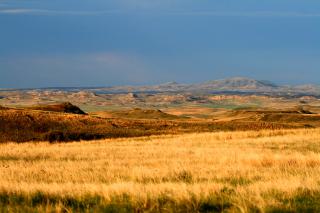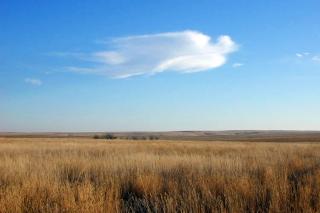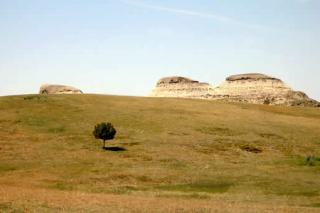Ecosystem Services from National Grasslands

The Forest Service currently administers twenty National Grasslands consisting of 3.8 million acres of public land. These grasslands are managed for a variety of purposes including forage, fish and wildlife, timber, water, and recreation resources. While National Grasslands are valued for these basic goods, they also deliver other important services that are often perceived to be free and limitless. Taken for granted as public benefits, ecosystem services lack a formal market and are traditionally absent from society’s balance sheet. As a result, their critical contributions are overlooked in public, corporate, and individual decision-making. The Forest Service is working to promote public awareness of the importance of forests and grasslands to human well-being.
What are Grassland Ecosystem Services?
The health and well-being of human populations depend on the services provided by ecosystems and their components: the organisms, soil, water, and nutrients. Ecosystem Services are the process by which the environment produces resources such as clean water, forage, and range; habitat for wildlife; and pollination of native and agricultural plants.
National Grassland Ecosystems provide services that:
- Disperse seeds
- Mitigate drought and floods
- Cycle and move nutrients
- Detoxify and decompose waste
- Control agricultural pests
- Maintain biodiversity
- Generate and preserve soils and renew their fertility
- Contribute to climate stability
- Regulate disease-carrying organisms
- Protect soil from erosion
- Protect watersheds, and stream and river channels
- Pollinate crops and natural vegetation
- Provide aesthetic beauty
- Provide wildlife habitat
- Provide wetlands, playas
- Provide recreation
- Provide research opportunities
What Are Grassland Ecosystem Services Worth?
Over 1 million visitors annually enjoy the ecosystem services provided on the National Grasslands. Aesthetic beauty is one example of an ecosystem service provided on the grasslands for which there is no substitute. For many, nature is a source of wonderment and inspiration, peace, solitude, beauty and rejuvenation. The estimated value of aesthetic and passive use of forest ecosystem services alone is $280 million a year in the United States. Our National Grasslands provide aesthetic beauty in many forms including wildlife viewing by being home to a diversity of species including golden eagles, grouse, pronghorn, elk, prairie dogs, and bison. National Grassland units contain the largest representation of threatened and endangered species. In addition, our grasslands contain thousands of species of wildflowers, and stunning grass filled vistas that are available year-round for the viewing enjoyment of our public.
Natural ecosystems and the plants and animals within them provide humans with services that would be very difficult to duplicate. For example, pollination is a service for which there is no technological substitute. Our National Grasslands provide habitat for thousands of species of pollinators. While it is often impossible to place an accurate monetary amount on ecosystem services, we can calculate some of the financial values. Many of these services are seemingly performed “free” and yet are worth many trillions of dollars. Over 100,000 different animal species - including bats, bees, flies, moths, beetles, birds, and butterflies - provide free pollination services. One third of human food comes from plants pollinated by wild pollinators. The value of pollination services from wild pollinators in the United States alone is estimated at four to six billion dollars per year.
Most scientists believe there is a direct relationship between increased levels of carbon dioxide in the atmosphere and rising global temperatures. Through the process of photosynthesis, plants capture carbon dioxide and remove it from the atmosphere. Because the National Grasslands contain large areas of intact prairie and other grassland types, they provide the ecosystem service of carbon sequestration in grassland vegetation and soil organic matter. Grassland ecosystem services help sustain, support, and fulfill human life. These services can be tangible or intangible, but they are nevertheless critical for sustaining human well-being.
For More Information
- Ecological Society of America
- Ecological Society of America - Carbon Sequestration in Soils (PDF, 0.6 MB)
- Ecological Society of America. Issues in Ecology, "Ecosystem Services: Benefits Supplied to Human Societies by Natural Ecosystems" (PDF, 0.5 MB). No. 2, Spring, 1997, Ecological Society of America.
- Harris, J. A., R. J. Hobbs, E. Higgs, and J. Aronson. 2006. Ecological Restoration and Global Climate Change. Restoration Ecology. Vol. 14, No. 2: 1y70-176.
- Krieger, D. J. 2001. Economic Value of Forest Ecosystem Services: A Review. The Wilderness Society, Washington, D.C.
- Millennium Ecosystem Assessment (MA). 2005. Ecosystems and Human Well-being: Synthesis (PDF, 14.9 MB). Washington, DC: Island Press. 137 p. (August 22, 2007).
- Myers, N. 1995. Environmental services of biodiversity. Proc. Natl. Acad. Sci. USA Vol. 93: 2764-2769.
- Sustainable Rangelands Roundtable
- Maczko, Dr. Kristie, Ms. Lorie Hidinger, editors. 2008. Sustainable Rangelands Ecosystem Goods and Services (PDF, 2.2 MB). 111 p. Sustainable Rangelands Roundtable.
- U.S. Forest Service Ecosystem Services


